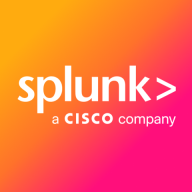

Dynatrace and Splunk Observability Cloud compete in the monitoring and analytics category, offering robust solutions for application performance management. User reviews suggest Dynatrace holds an edge with its continuous innovation and comprehensive feature set, while Splunk is praised for its efficient data correlation and fast service.
Features: Dynatrace distinguishes itself with its PurePath technology, enabling deep application monitoring, AI insights for automated problem detection, and dynamic reporting capabilities for flexibility and user experience analysis. Splunk Observability Cloud offers comprehensive metrics, including synthetic and real user monitoring, dashboards for data visualization, and efficient data correlation.
Room for Improvement: Dynatrace's complicated pricing model and occasional user interface challenges have been noted, along with suggestions for additional integrations. Splunk Observability Cloud is seen as expensive, with room to improve AI-driven functionalities and integration capabilities with third-party tools.
Ease of Deployment and Customer Service: Dynatrace provides a robust deployment option for on-premises and cloud setups, with generally positive customer support, though some users request enhanced technical expertise. Splunk Observability Cloud’s integration with public and private clouds is smooth but may require extra setup effort. It receives praise for fast customer service, with suggestions for more proactive assistance.
Pricing and ROI: Despite its feature-rich offering, Dynatrace's pricing is deemed high but users report significant ROI through tool consolidation and operational efficiency improvements. Splunk Observability Cloud, known for its cost, offers justified investment considering its capabilities and support, advising buyers to evaluate the total cost and benefit for specific needs.
ROI is hard to specify; however, incidents like impending ransomware attacks highlight its value, though those are exceptional events.
Using Splunk has saved my organization about 30% of our budget compared to using multiple different monitoring products.
Anyone working in front-end management should recognize the market price to see the true value of end-user monitoring.
I have definitely seen a return on investment with Splunk Observability Cloud, particularly through how fast it has grown and how comfortable other teams are in relying on its outputs for monitoring and observability.
They have a good reputation, and the support is commendable.
The technical support from Dynatrace is excellent.
For Dynatrace tech support, we have a dedicated team here, which is easily reachable.
On a scale of 1 to 10, the customer service and technical support deserve a 10.
They have consistently helped us resolve any issues we've encountered.
They often require multiple questions, with five or six emails to get a response.
If it's an enterprise, increasing the number of instances doesn’t pose problems.
We've used the solution across more than 250 people, including engineers.
As we are a growing company transitioning all our applications to the cloud, and with the increasing number of cloud-native applications, Splunk Observability Cloud will help us achieve digital resiliency and reduce our mean time to resolution.
I would rate its scalability a nine out of ten.
Generally, all are stable at ninety-nine point nine nine percent, but if the underlying infrastructure is not deployed correctly, stability may be problematic.
There have been no stability issues with Dynatrace.
I would rate its stability a nine out of ten.
We rarely have problems accessing the dashboard or the page.
Unlike NetScout or regular agents for APM, RUM has many problems during the POC phase because customer environments vary widely.
The definition of enterprise is loosely used, however, from a holistic security perspective, including infrastructure, network, ports, software, applications, transactions, and databases, there are areas lacking, especially in network monitoring tools.
I'm specifically looking at AIOps and how we can monitor AIOps-related things, considering we have LLMs and all that stuff.
They have been the pioneers from inception, and they remain at the top of the Gartner chart.
The out-of-the-box customizable dashboards in Splunk Observability Cloud are very effective in showcasing IT performance to business leaders.
The next release of Splunk Observability Cloud should include a feature that makes it so that when looking at charts and dashboards, and also looking at one environment regardless of the product feature that you're in, APM, infrastructure, RUM, the environment that is chosen in the first location when you sign into Splunk Observability Cloud needs to stay persistent all the way through.
There is room for improvement in the alerting system, which is complicated and has less documentation available.
Dynatrace is known to be costly, which delayed its integration into our system.
If I would ask you to rate price from 1 to 10, where 1 is cheap and 10 is expensive, how many points would you give to it?
Splunk is a bit expensive since it charges based on the indexing rate of data.
It is expensive, especially when there are other vendors that offer something similar for much cheaper.
It appears to be expensive compared to competitors.
The integration with Power BI for generating detailed reports is a standout feature.
Dynatrace's AI-driven Davis engine absolutely helps identify performance issues by showing root cause analysis for us up to 200%; whatever is integrated, if it is visible, it can stitch and show.
Graduation features offered by Dynatrace provide a single view and can connect with many other monitoring systems.
Splunk provides advanced notifications of roadblocks in the application, which helps us to improve and avoid impacts during high-volume days.
For troubleshooting, we can detect problems in seconds, which is particularly helpful for digital teams.
It offers unified visibility for logs, metrics, and traces.
| Product | Market Share (%) |
|---|---|
| Dynatrace | 8.9% |
| Splunk Observability Cloud | 2.0% |
| Other | 89.1% |


| Company Size | Count |
|---|---|
| Small Business | 76 |
| Midsize Enterprise | 50 |
| Large Enterprise | 289 |
| Company Size | Count |
|---|---|
| Small Business | 20 |
| Midsize Enterprise | 10 |
| Large Enterprise | 43 |
Dynatrace is an AI-powered software intelligence monitoring platform that accelerates digital transformation and simplifies cloud complexities. Dynatrace is an entirely automated full-stack solution that provides data and answers about the performance of your applications and deep insight into every transaction throughout every application, including the end-user experience. By modernizing and automating enterprise cloud operations, users can deliver an optimal digital experience with higher quality software to customers faster.
Dynatrace offers an all-in-one automated artificial intelligence solution that brings together application performance, cloud and infrastructure, and digital experience monitoring. Dynatrace accelerates performance-driven results through operations, development, and business teams with a shared metrics platform. In addition, users are provided a full-stack monitoring experience with three patented technologies:
What does Dynatrace offer?
Dynatrace redefines how organizations monitor their digital ecosystems. The solution offers:
Reviews from Real Users
Dynatrace is the only solution that provides answers to organizations based on deep insight into each user, transaction, and organization's environment.
Barry P., a managing performance engineer at Medica Health Plans, writes, "With Dynatrace, we have synthetic checks and real-user monitoring of all of our websites, places where members and providers can interact with us over the web. We monitor the response times of those with Dynatrace, and it's all integrated into one place."
A consultant at a tech service company notes, "A feature that's one of the highlights of Dynatrace is the AI. The second most valuable feature is OneAgent. Between infrastructures, applications, operating systems, you can deploy with just a single agent and can practically install and forget about it."
Splunk Observability Cloud offers sophisticated log searching, data integration, and customizable dashboards. With rapid deployment and ease of use, this cloud service enhances monitoring capabilities across IT infrastructures for comprehensive end-to-end visibility.
Focused on enhancing performance management and security, Splunk Observability Cloud supports environments through its data visualization and analysis tools. Users appreciate its robust application performance monitoring and troubleshooting insights. However, improvements in integrations, interface customization, scalability, and automation are needed. Users find value in its capabilities for infrastructure and network monitoring, as well as log analytics, albeit cost considerations and better documentation are desired. Enhancements in real-time monitoring and network protection are also noted as areas for development.
What are the key features?In industries, Splunk Observability Cloud is implemented for security management by analyzing logs from detection systems, offering real-time alerts and troubleshooting for cloud-native applications. It is leveraged for machine data analysis, improving infrastructure visibility and supporting network and application performance management efforts.
We monitor all Application Performance Monitoring (APM) and Observability reviews to prevent fraudulent reviews and keep review quality high. We do not post reviews by company employees or direct competitors. We validate each review for authenticity via cross-reference with LinkedIn, and personal follow-up with the reviewer when necessary.